Carbon Through a Supply Chain Lens
Digital Tactics to Drive Decarbonization
With supply chains facing a large carbon reduction challenge, our research provides a comprehensive breakdown of the carbon flows as a step to identify tech solutions that solve for decarbonization.
Executive Summary
Digitizing to decarbonize supply chain functions begins in a logical space: following the numbers…
Understanding the details behind today’s GHG emissions is required for supply chain teams to create scenario analyses and prioritize initiatives, then engage with solution providers on relevant technology solutions.
But the challenge with the current views of annual emissions is that the categories of emissions used by analysts rarely align to supply chain operations. In seeking a view aligned to supply chain functions, we could not find one. But, identifying relevant technology solutions requires it—especially as supply chain teams aim to develop a “carbon intuition” for better decision making.
Our research analyzed 51 billion tons of annual GHG emissions against the Zero100 Loop:
Source | 16.6 billion tons: Includes the emissions from materials like plastics, metals, animals, and crops. It includes land use as well as land use changes.
Make | 10.9 billion tons: Includes the energy used in factories and the CO2 that is created as a result of chemical reactions, for example from creating cement.
Move | 5.5 billion tons: Includes the energy used in warehouses and distribution centers, and the combustion of fossil fuels used to power various transportation modes.
Sell | 1 billion tons: Includes energy for commercial spaces such as retailers and services.
Use | 15.4 billion tons: Includes energy to power residential homes and the commercial spaces used for use, such as health care. It also includes passenger aviation and road travel.
Regenerate | 1.6 billion tons: Includes the current end-of-life processes of landfill and wastewater treatment.
This analysis is a starting point to identify the needs of technologies. We identify two categories of digitization for decarbonization: Tech for Today, and Breakthrough for Tomorrow. This research directs the focus for technology engagements, with future research diving into each functional area.
The Goal is 51 Billion Tons
Before the supply chain community can use digitize to decarbonize, it is critical to know what that technology needs to do. This means understanding the functional area of focus, the buying executive, and the profile of the power user.
Most research groups agree that annual GHG emissions are 51 billion tons a year (give or take a billion), but these 51 billion tons can be viewed in many ways, such as manufacturing and consumer activities. GHG emissions are expressed in carbon dioxide equivalent (CO2e) and the vast majority, about 75%, come from energy. This energy could be to run factories and mines and processing facilities, or by using fuel to create energy to run your fleets. While all emissions are ultimately created because of a human need or desire, this research views emissions through a supply chain lens—allocating them into the supply chain functions to identify the accountable supply chain leaders.
The role of technology is broad. For example, most supply chains are heavily outsourced but just a handful have visibility beyond their second tiers. Supply chains try to problem solve in a variety of ways, from 3rd party solution providers to consultants to internally created systems. This research explores the role of technology in decarbonizing supply chain operations.
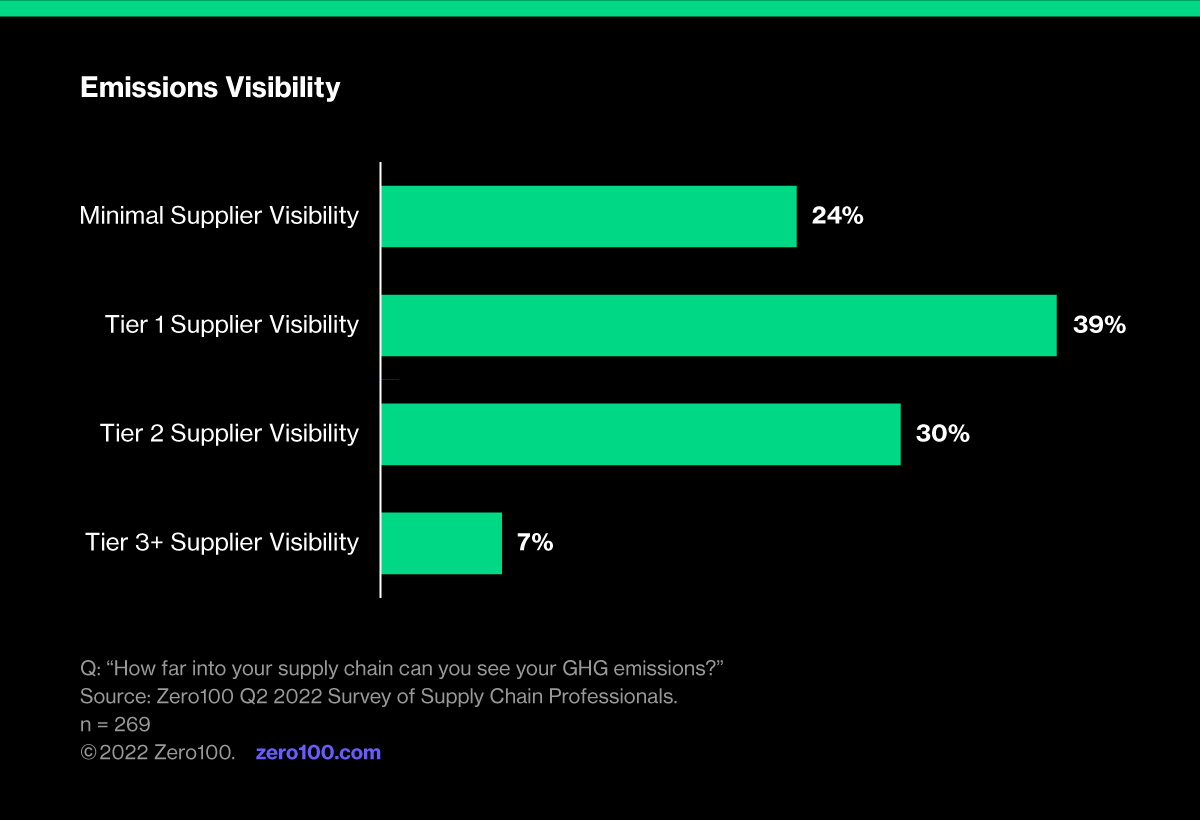
Many Ways to View Carbon Emissions
In defining the goal and desired results for using digital solutions to reduce carbon, the first logical step is to identify a specific target. For supply chain leaders, this is more difficult than it may first seem.
Understanding the details behind the 51 billion tons is required for supply chain teams to create scenario analyses and prioritize initiatives.
The challenge with the current views of annual emissions is the categories used by analysts rarely align to supply chain operations. Each group takes a slightly different view, for example displayed by sector or societal needs. While a few standards exist for calculating emissions, the categories and guidance rarely align to how a supply chain operates.
But, identifying relevant technology solutions requires it – especially as supply chain teams aim to develop a “carbon intuition” for better decision making.
Therefore, we set out to create a view created especially for CSCOs and their teams.
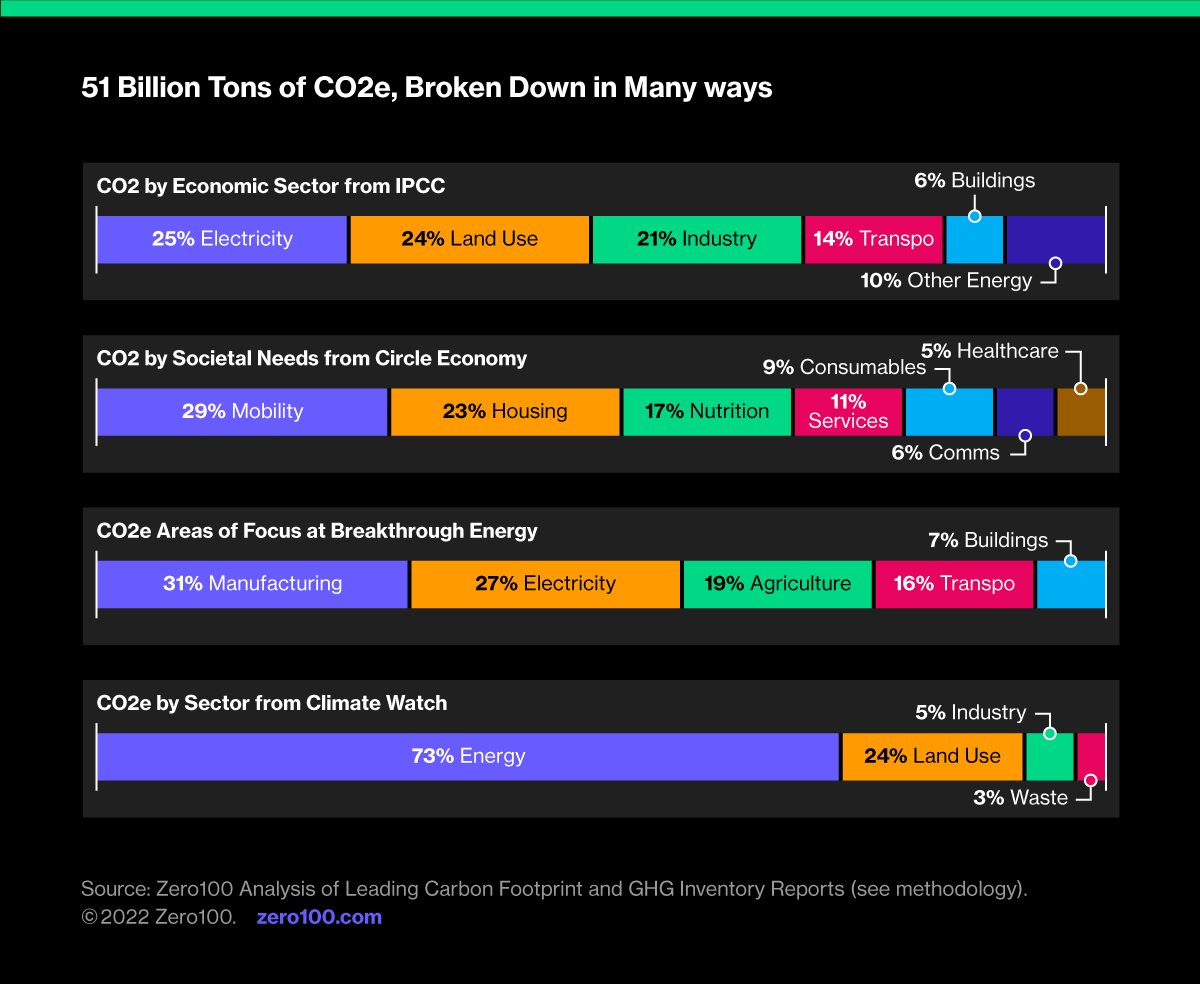
51 Billion Tons Through a Supply Chain Lens
Analyzing 51 billion tons of CO2e to align to supply chain functional operations results in a view that supply chain leaders can use to identify areas of focus and opportunities for partnership.
The functions with the highest level of carbon guardianship are Source (32%) and Use (30%), followed by Make (21%), Move (11%) and small contributions from Regenerate (3%), and Sell (2%). To get to this view, we analyzed the emissions from various activities.
We did not include the Plan function. While more accurate planning will certainly lead to lower carbon emissions, our research shows that the emissions impacted by Plan happen inside another functions, such as Source and Make.
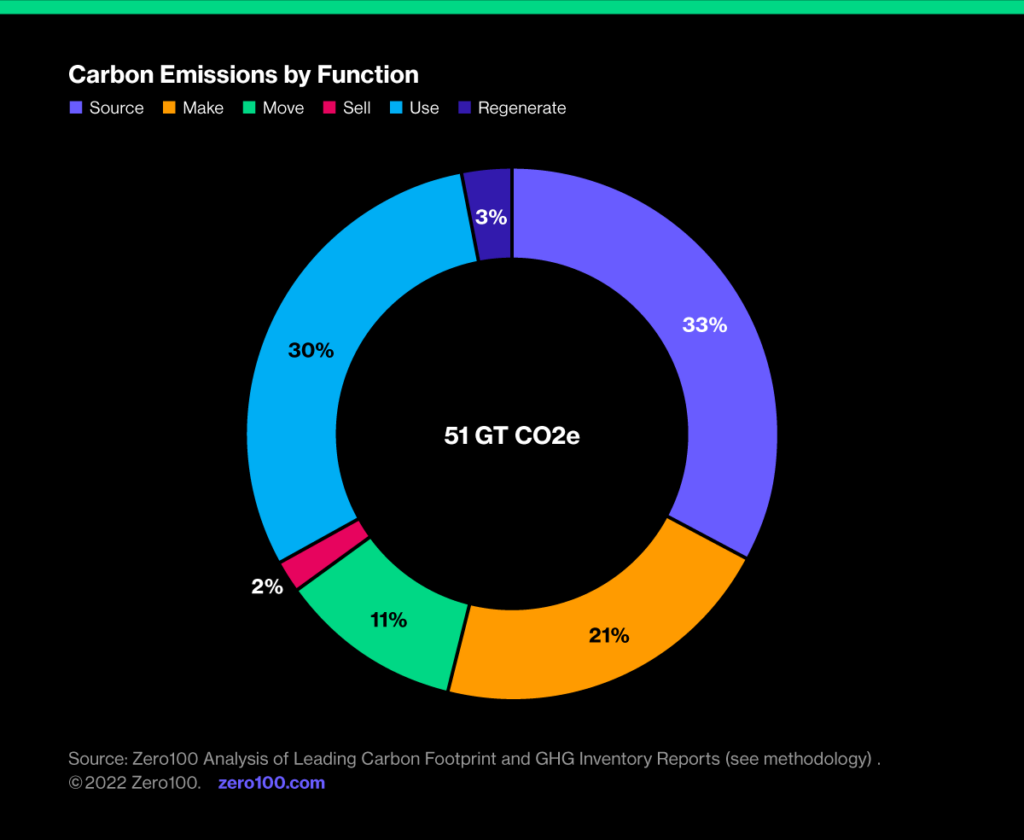
A Functional View of Carbon
Viewing carbon in functional categories allows CSCOs to prioritize focus areas and investments based on scenario planning and solution provider capabilities.
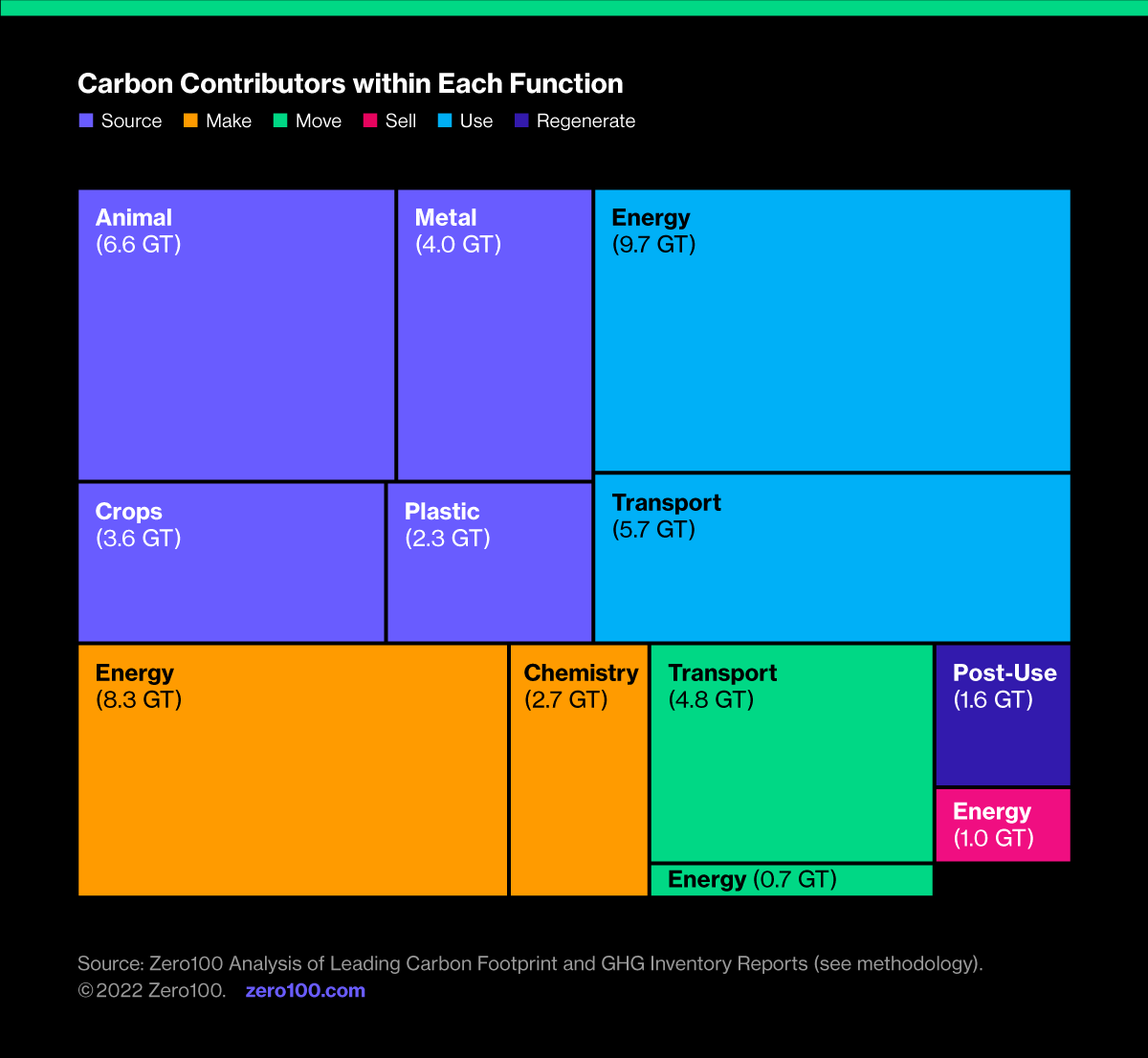
The following section summarizes the findings of each functional area, and identifies two categories of digitization: Tech for Today, and Breakthrough for Tomorrow and begins with high-energy supply side functions Source, Make, Move, then closing with demand-side summaries of Use, Sell, Regenerate.
16 BILLION TONS
Digitize to Decarbonize: Source
Each year, as a global society, we extract and use 100 billion tons of materials. These materials are brought into economies by sourcing teams around the world.
Responsible sourcing requires auditable transparency from upstream suppliers, but visibility past the first or second tier supplier is a challenge – today’s operations were not designed or optimized for visibility.
Technology can help increase this transparency and optimize for decisions that blend cost savings, time, quality – and carbon.
The emissions from your sourcing team will vary depending, of course, on the materials you use. For example, land use for humans (e.g., food and materials) contributes fewer emissions than raising animals (e.g., meat, dairy, eggs and leather); and steel is a major challenge – contributing over 7% of all global emissions.
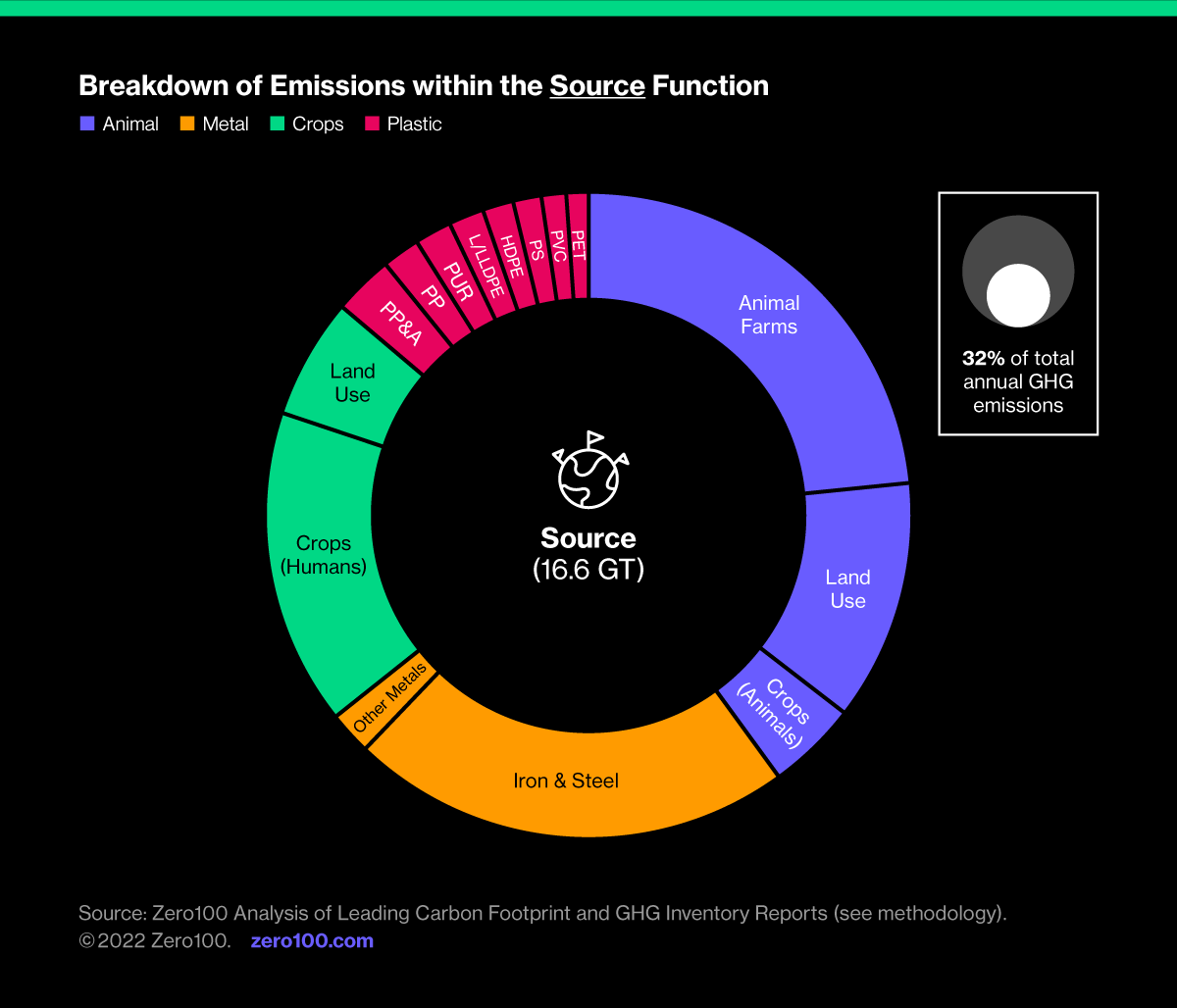
Technologies to Tackle Emissions from Source
Tech for Today includes partnering with suppliers to apply the technologies also used in your own Make and Move functions to reduce their emissions – therefore reducing the emissions caused through the demand signal of your sourcing team.
Breakthroughs in Source are exciting. Using low-carbon materials by designing for circularity is one path. Another, is using materials as a carbon sink. “What if everything we’re surrounded with was removing emissions instead of releasing them?” said Neema Shams of Made of Air, an innovation of carbon-negative bioplastic.1 Several scenarios show solutions where Source offers a path to remove more carbon that emits– a path to regeneration.
Tech For Today
Supplier Energy | 4.3 gigatons
Partner with material suppliers to collectively transition to renewable energies. Consider leading for your suppliers, creating a PPA like Walmart’s Project Gigaton.
Supplier Fuel | 3.1 gigatons
Create best practice sharing among suppliers to embrace energy and fuel management systems, such as reducing carbon with Fleetenergies.
Breakthrough
Low Carbon Materials | 4.8 gigatons
Green Mining is digitizing the informal waste picking industry and helping AB InBev reuse packing.
Carbon-Full Materials | 7.8 gigatons
Air Protein, subsidiary of biotech Kiverdi, Inc. can remove CO2 from industrial sources or direct air capture, and turn it into edible protein for humans, reducing carbon from raising meat.
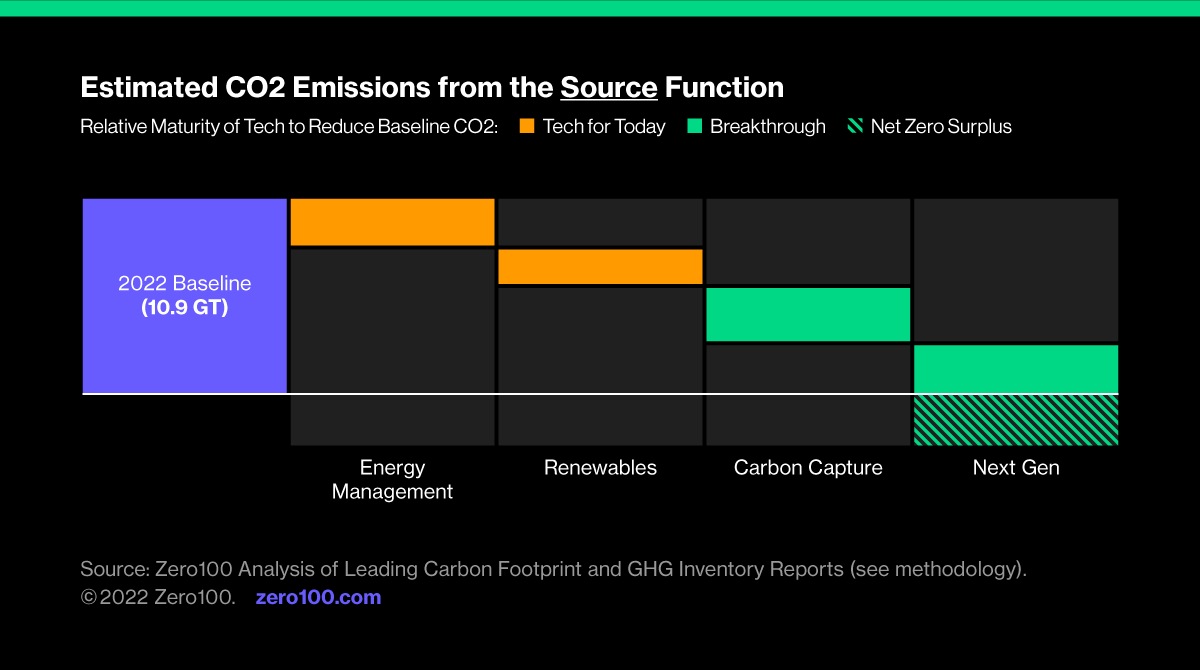
10.9 BILLION TONS
Digitize to Decarbonize: Make
Manufacturing teams around the world work through several tiers. Each knows their own tier but very few manufacturers can see beyond their second tier.
This, of course, presents distinct challenges for supply chains aiming to understand and eliminate the carbon emissions from their networks.
The great debate is how to combine concepts like Extended Producer Responsibility with pending carbon taxes. Supply chains who have a strong relationships with their manufacturing partners are well placed to reduce carbon emissions. The major causes of emissions for Make leaders to manage varies based on location and industry. The largest contributor to emissions for Make leaders is the source of energy for the network of factories. The other cause of emissions comes from chemical reactions – the largest of which is cement.
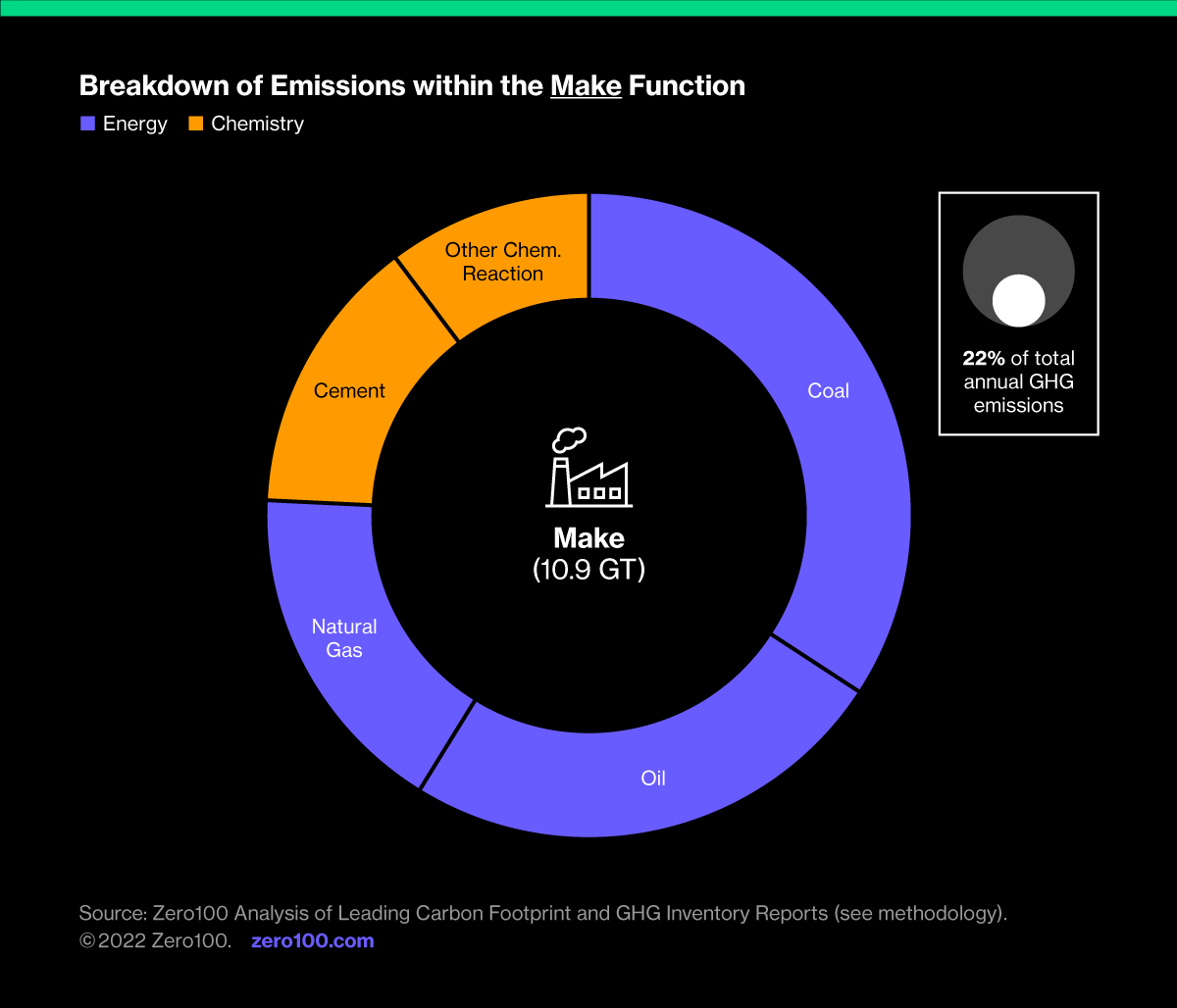
Technologies to Tackle Emissions from Make
Tech for Today includes leveraging today’s solutions to manage energy and other utilities for factories – expressed as “W.A.G.E.S.” (water, air, gas, electric, steam). Solution providers combine physical sensors with analytics to identify and reduce energy needed – and with it, the carbon emitted from that energy production. Renewable energy can be accessed through the grid or through on-site production.
Breakthroughs in Make are broad! Carbon capture from factories using identification and capture is one path. “Next Gen” is another, covering 3D printing, wide-scale dis/reassembly and repair. It’s promising for the P&L, as well. “This is a game-changer,” GE Aviation Additive Manufacturing Leader Eric Gatlin said. “It was cheaper doing it with additive than casting.”2
Tech for Today
Energy Management | 2.2 gigatons
Gaining efficiencies in W.A.G.E.S. with a partner like Rockwell to identify and improve energy use in factories.
Renewables | 2.3 gigatons
A transition to renewable energy sources, from the grid or from on-site leased production as Method Soap has done.
Breakthrough
Carbon Capture | 2.5 gigatons
Using a solution like Honeywell’s Carbon Capture solution to reduce emissions from the point of source at the factory.
Next Gen Manufacturing | 3.9gigatons
The future of manufacturing sees a higher focus on carbon-lowering activities like automation, 3D printing and a repair-first approach, such as through MOGL.
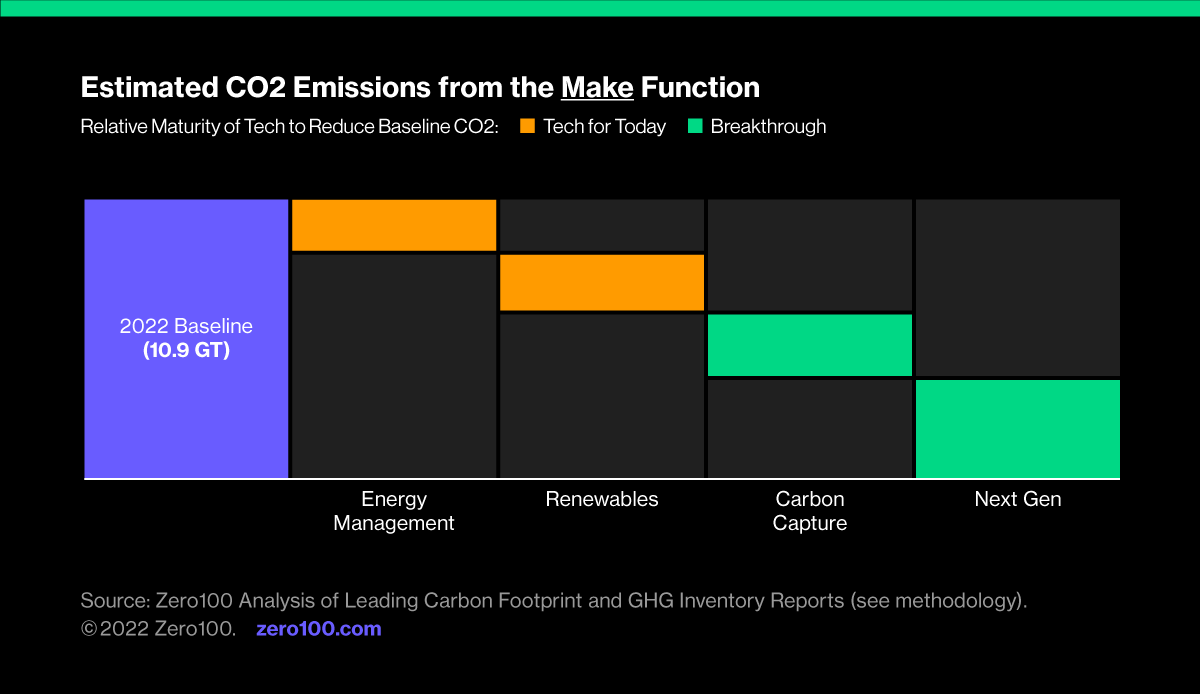
5.5 BILLION TONS
Digitize to Decarbonize: Move
Academic thought leader Alan McKinnon first published on carbon in logistics over 25 years ago. In his most recent book, he writes that Move leaders “can gain support, encouragement and morale from industry-wide green freight schemes.”3
Industry-wide collective action is needed in all functions, but especially in Move where sharing of lanes, assets, and facilities is the norm for most supply chains. This collective action can be focused on the largest causes of emissions.
For Move, fuel for transportation makes up the bulk of emissions with road transport driving over half (3 gigatons) and the rest coming from the energy needed for warehouses and distribution centers.
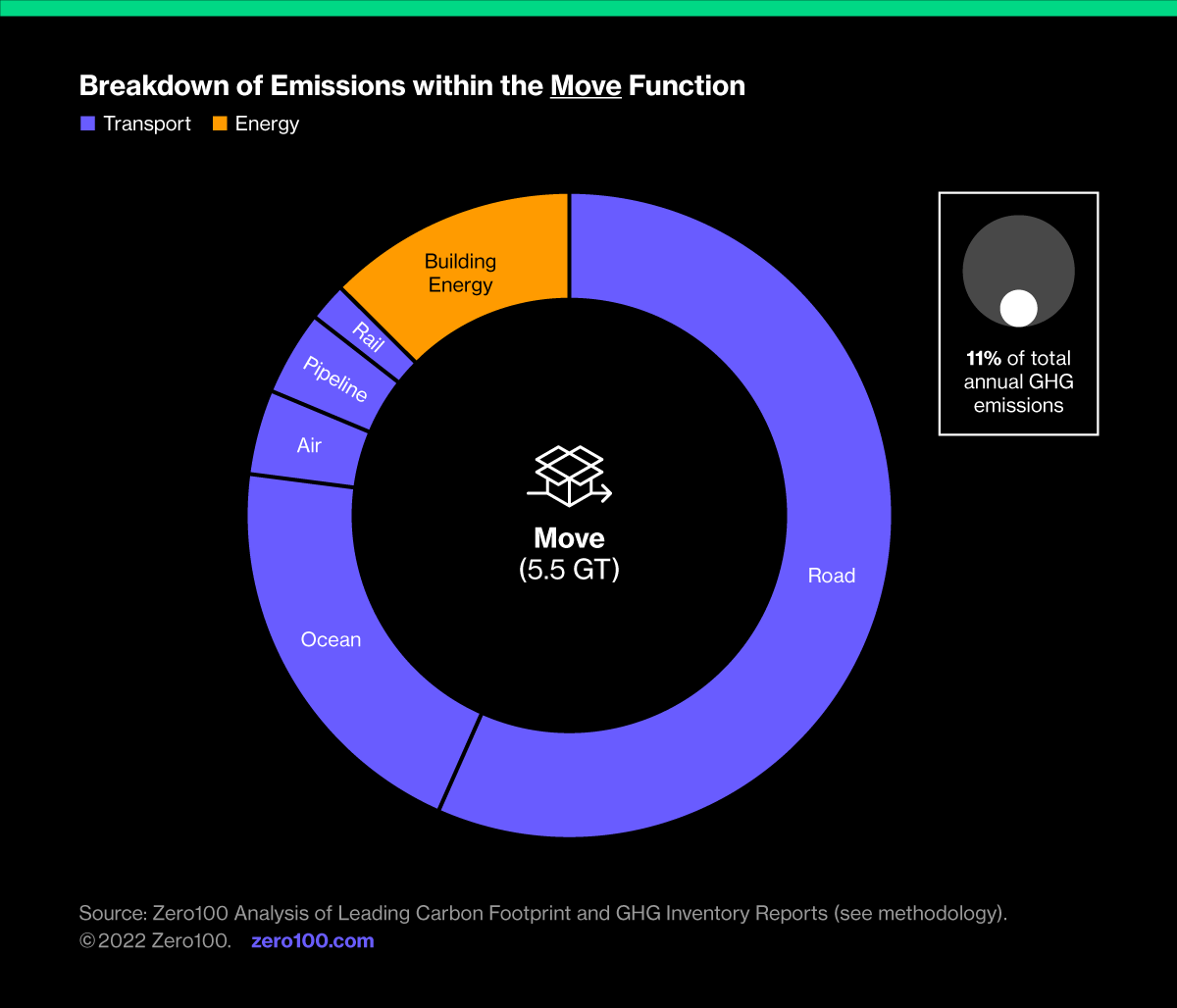
Technologies to Tackle Emissions from Move
Tech for Today tackles two main categories. The first is optimizing operations today – making better use of space, including more efficiently packaged and loaded fleets, smarter routes, and higher first-time deliveries. The second category is energy management for building infrastructure with technology assists for transitioning to renewable energy from the grid or creating it on-site.
Breakthroughs for Move are where the big impact will come. Using technology to capture carbon at the “point of emissions” means a pathway to retrofitting existing vehicles while we wait for the EV transition to happen. Plus, innovative fuels using carbon from the air can be used in existing vehicles, with a nearly neutral carbon impact.
Tech For Today
Route Optimization | 0.6 gigatons
Carbon reduction can come from partners like FarEye for better route planning, successful deliveries and improved loading.
Energy Management | 0.2 gigatons
A transition to renewable energy sources, from the grid or from on-site leased production, with a partner like SunPower.
Breakthrough
Carbon Capture | 2.2 gigatons
Retrofitting vehicles for carbon capture can create a revenue stream, for example with Remora’s CO2 compressor.
Fuel Alternatives | 2.5 gigatons
The future will see alternative fuels such as electrification and hydrogen created from clean energy sources, or fuel created from carbon such as Infinium.
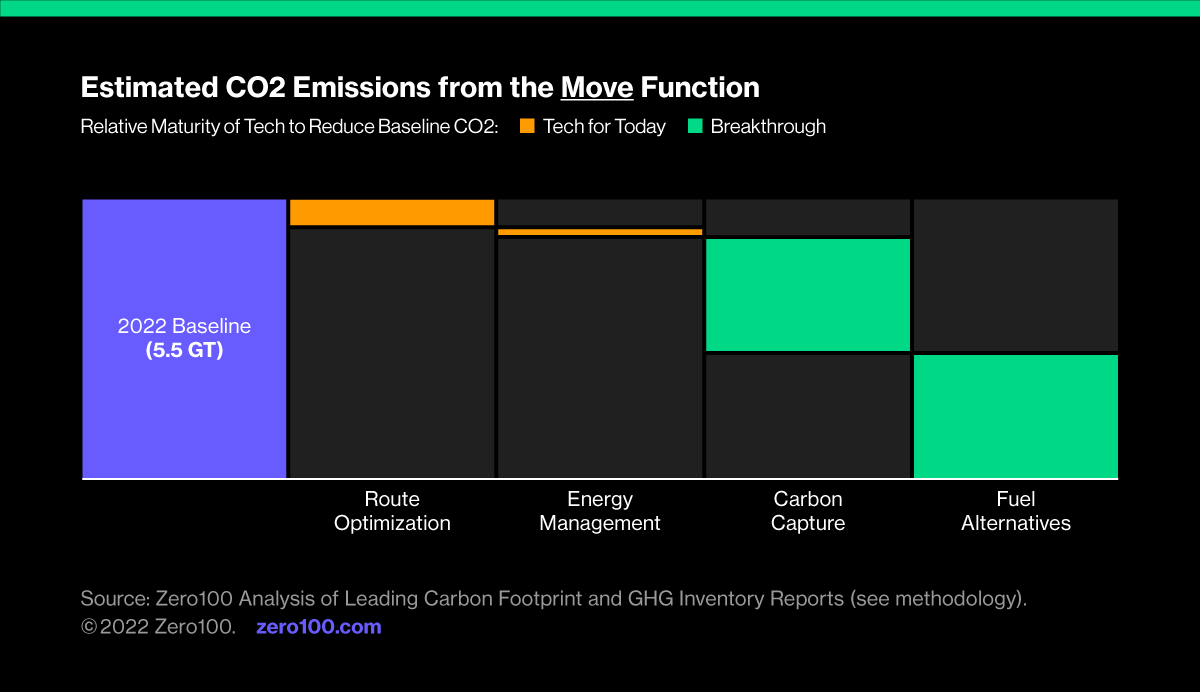
1 BILLION TONS
Digitize to Decarbonize: Sell
Clocking in at a single gigaton, the Sell function is the smallest contributor to global emissions. But the future of buildings and how supply chains connect to their ultimate users is a space that has been disrupted and is in transition.
Emissions in Sell come from the energy needed to power the spaces people go to buy goods and services. Traditional malls are on a trajectory to close,4 with spaces reallocated as community centers and parks.5
As “the channel” gets reinvented as a digital-heavy relationship between brand and user, supply chains have a unique opportunity to move beyond demand signals to capture what some are starting to see: a desire signal.
In the Zero100 Loop, “Sell” is naturally paired with “Move,” as shaping demand also means shaping last mile.
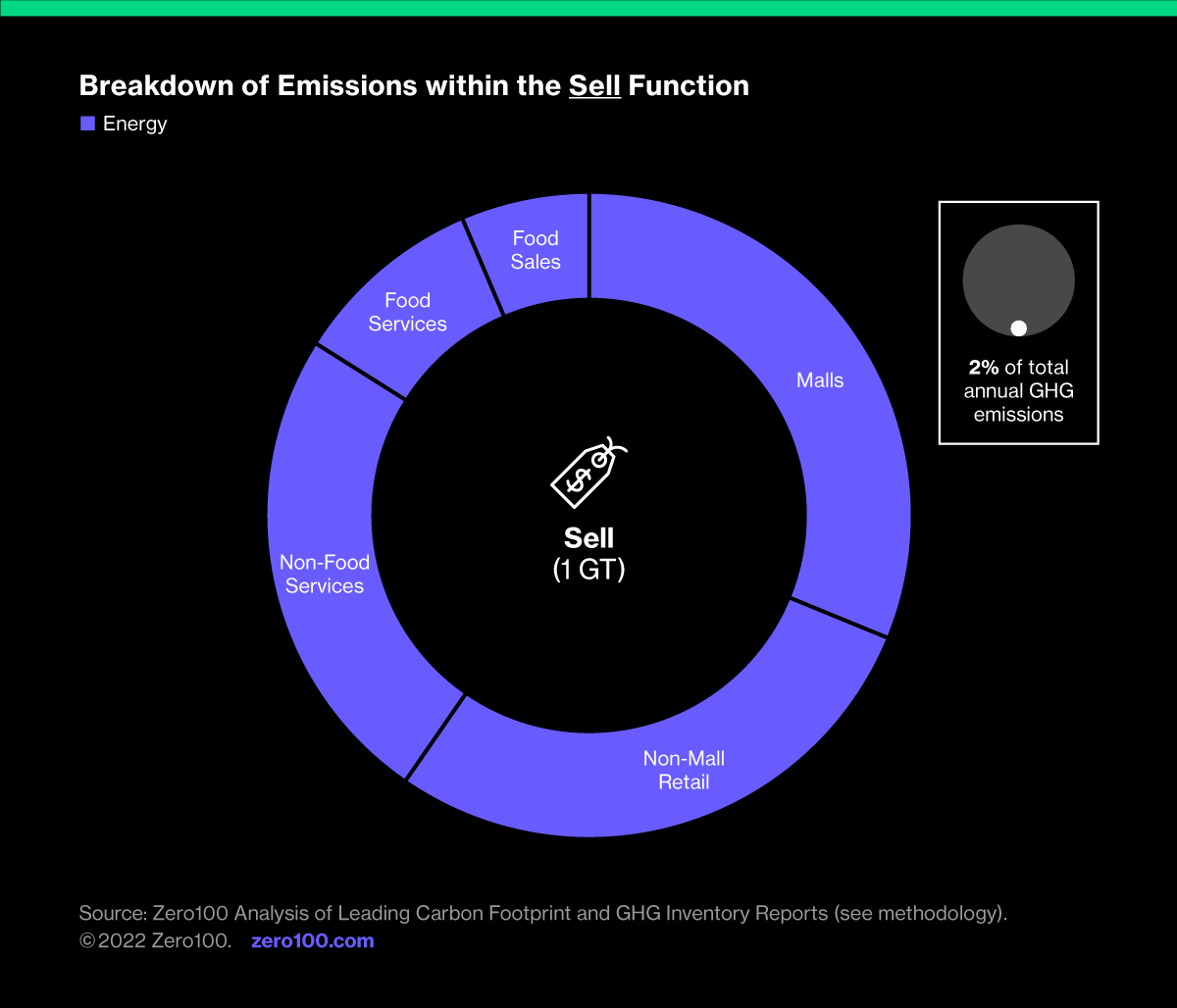
Technologies to Tackle Emissions from Sell
Tech for Today includes, predictably, energy management solutions. Retailers are likely already well versed in the potential to use sensors and advanced analytics to identify and – in many cases – dramatically reduce energy uses. Perhaps less predictable was a lesson from the pandemic on the potential of online shopping as a path to lower carbon. The impact for Move leaders is a trend acutely felt during the pandemic: a not-so-subtle shift in pack sizes, modes, lanes, and networks.
Breakthroughs for Sell will showcase what’s possible in smart, living buildings that heal themselves. With 28,000 sensors, one example comes from Deloitte’s Amsterdam offices as an example of the connected future of architecture.6
Tech For Today
Energy Management | 0.3 gigatons
Energy management provider Wattics works with supermarkets and other retail spaces to lower energy
Mode Shift | 0.1 gigatons
The pandemic offered a unique time to show that shifting from bricks-and-mortar to online offers a carbon reduction.
Breakthrough
Smart Buildings | 0.3 gigatons
Self-monitoring commercial spaces can optimize energy operations, such as CISCO Spaces.
Living Buildings | 0.3 gigatons
Transforming commercial buildings into living environments with a partner like Scotscape reduce energy needed inside the building and sequester carbon at the same time
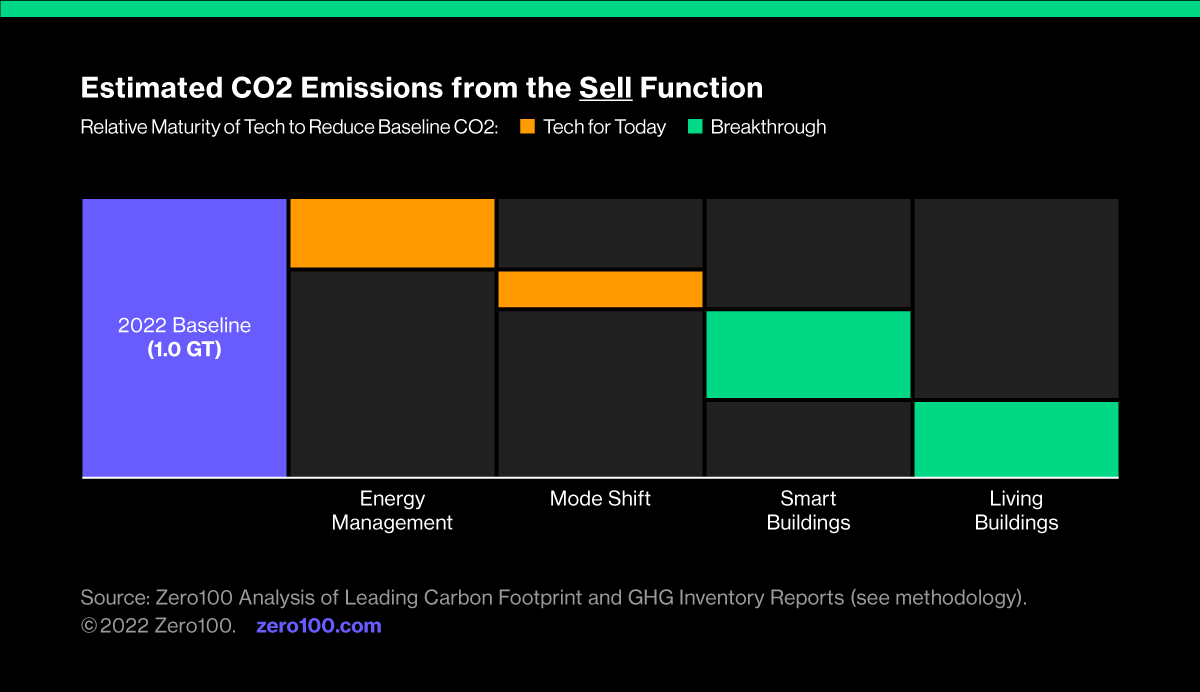
15.4 BILLION TONS
Digitize to Decarbonize: Use
Product and Service Use can be tricky for supply chain leaders to see and optimize, as digitization and analysis showing the “wheres” and “hows” of use is often limited.
In a similar vein as product quality, companies will soon be held responsible for the emissions efficiency – and potentially even the actual emissions – of product use. In the Zero100 Loop, “Use” is naturally paired with “Make,” as data around use can be fed back into Make to create a virtuous cycle.
Emissions from Use come from two areas: energy and transportation. In Energy, most comes from residential energy caused by the use of some product: charging a phone, heating up soup, or turning on a light to read a book. In Transport, most emissions come from passenger road travel.
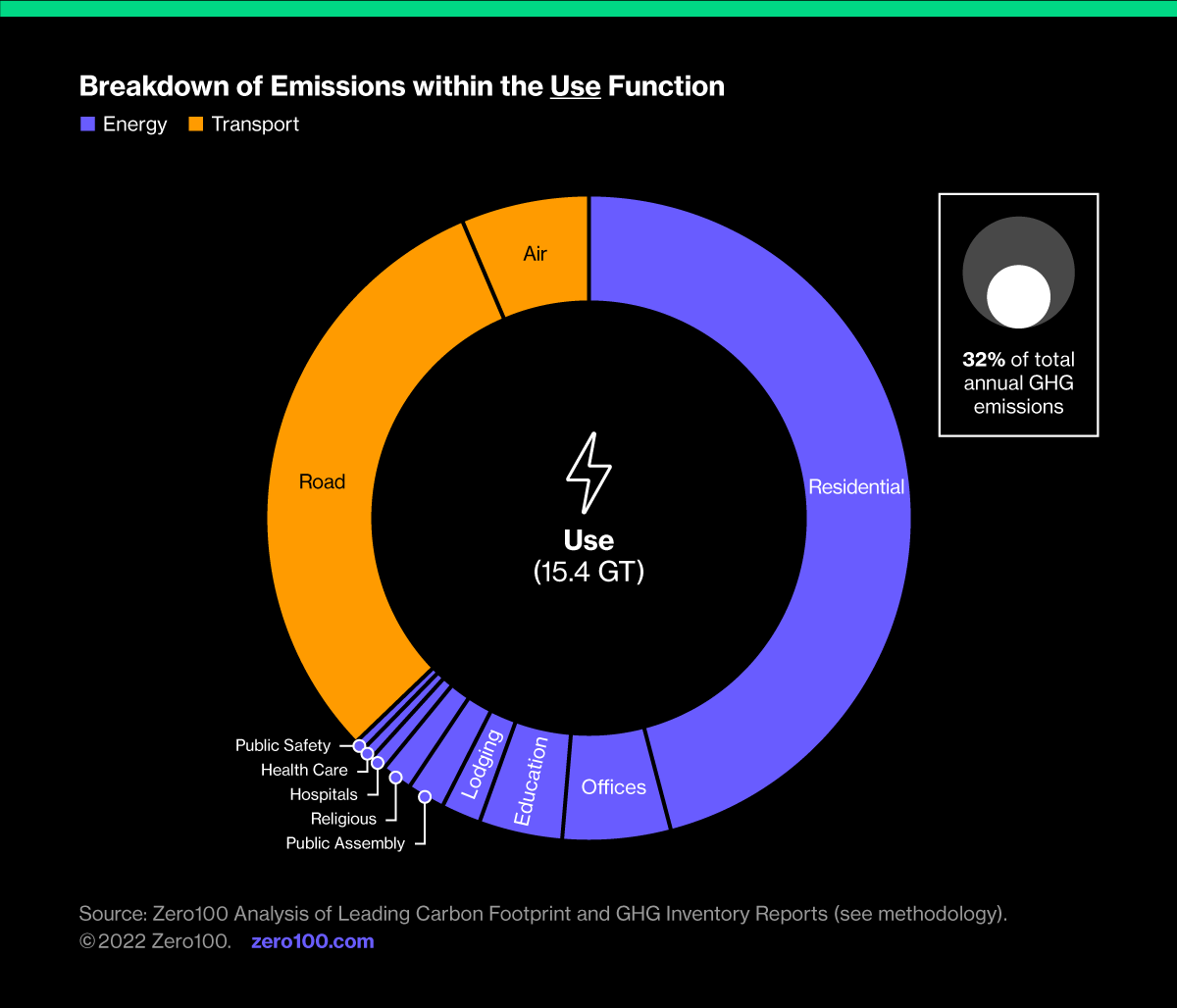
Technologies to Tackle Emissions from Use
Tech for Today includes technologies to monitor and reduce energy use at home. In-home monitoring is a hot space, with IoT devices set to turn off lights and other appliances when they aren’t needed, or smart thermostats that turn down the temperature when no one’s home. The transition to renewables is promising, with many governments issuing “how-to” guides for creating on-site sources, mainly through solar.
Breakthroughs will usher in a new way of living, with smart, living buildings that have the potential to sequester more carbon than they use. The Living Building Challenge™ offers a glimpse of what’s possible. Denis Hayes of the Bullitt Foundation explains “we wanted to set up a new regional vernacular for architecture; to make a building that is designed from the ground-up for the people who are going to be in it” – and perhaps, for the supply chains that support it.7
Tech For Today
Energy at Home | 1.7 gigatons
In-home monitors from providers like Sense reduce emissions and improve the supply chain’s services.
Renewables | 2.0 gigatons
Municipalities are focusing on a transition to on-site renewables, captured in this EPA Guide featuring cities across the country.
Breakthrough
Smart Buildings | 5.0 gigatons
Smart, living buildings offer major carbon reductions, modeled after world-leader Bullitt Center in Seattle, WA.
Fuel Alternatives | 6.7 gigatons
Passenger vehicles see a strong transition toward EVs, with Tesla leading the US market and others giving chase.
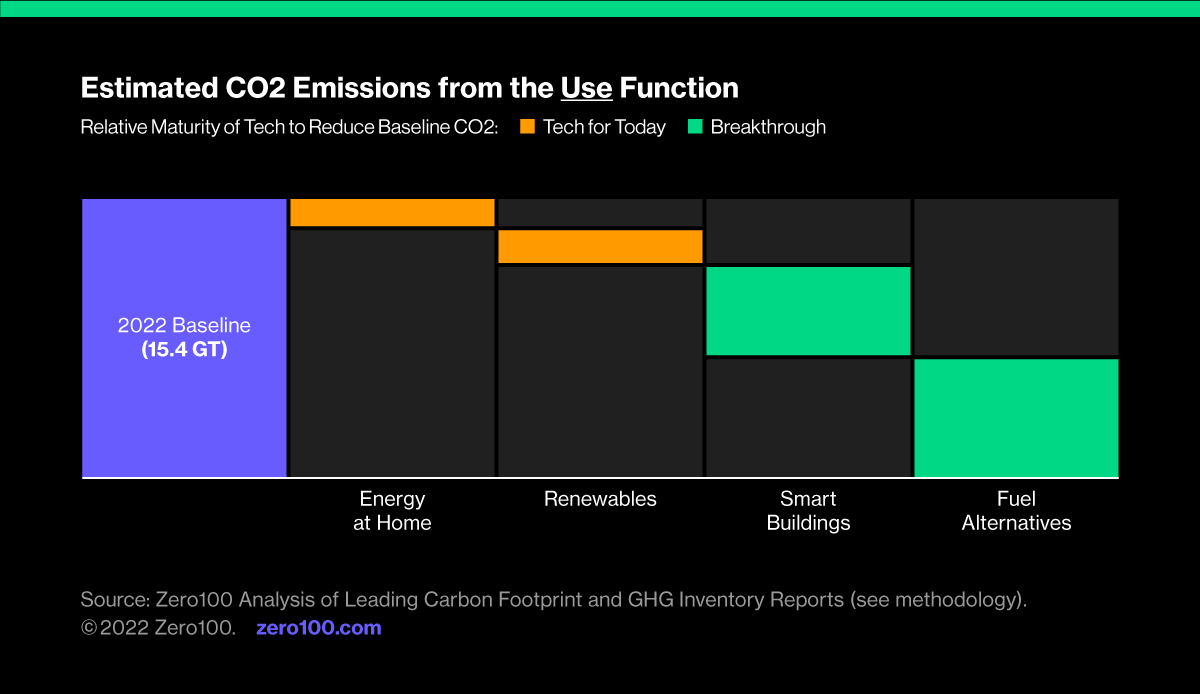
1.6 BILLION TONS
Digitize to Decarbonize: Regenerate
At first, it may seem strange to consider that Regenerate may have a carbon footprint. The space with endless potential and innovators is today mainly waste and water management.
The source of emissions mostly comes from fugitive emissions – those that escape a process and end up where they are not wanted. While some greenhouse gases are properly managed and repurposed;, others escape.
In the Zero100 Loop, “Regenerate” is naturally paired with “Source,” as the products and materials used in society can be circulated back into supply chains, both through Circularity Strategies for Sourcing and through Urban Mining.
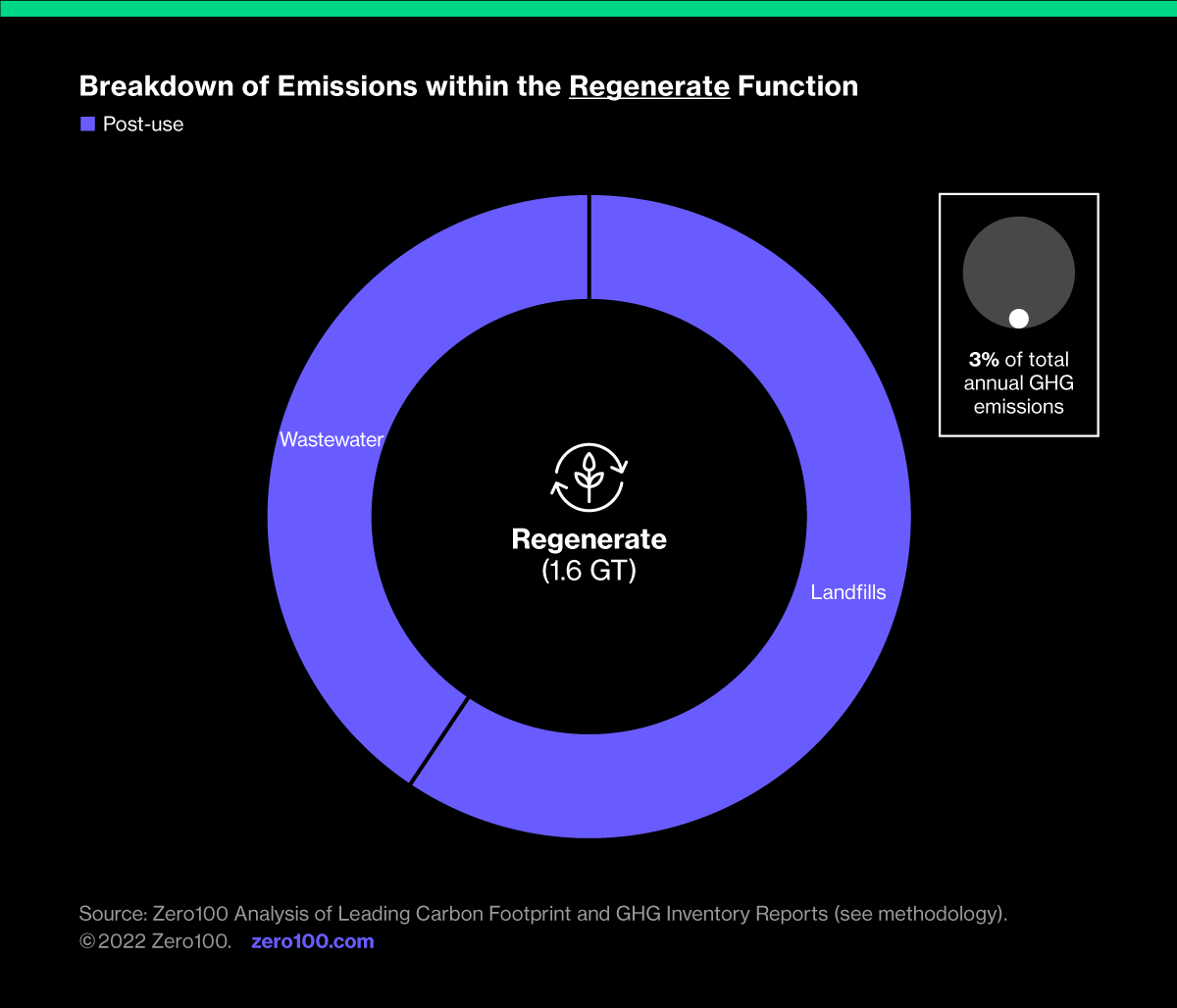
Technologies to Tackle Emissions from Regenerate
Tech for Today is all about tackling fugitive emissions. Solutions are offered by both established industrial players and also innovative start-ups, aiming to use machine vision to identify sources of fugitive emissions.
Breakthroughs offer – surprise – a path to regeneration. Reducing the need for resource extraction and replacing it with circularity and other approaches to value recovery means an avoidance of a high level of fugitive emissions that happen during fossil fuel extraction and mining operations today – over 15% of all emissions.8
Tech For Today
Landfill Capture | 0.3 gigatons
Carbon Mapper can identify the emission links from landfills so they can be managed, reduced, and eliminated.
Water Optimization | 0.2 gigatons
Sensors together with AI and systems controls can reduce the carbon from water systems, such as with GE Digital’s Water Solutions.
Breakthrough
Value Recovery | 2.3 gigatons
Capturing value from oceans, landfill, and cities reduces carbon by removing the need for new materials, such as with Li-Cycle and Ford.
Reduce Extraction | 4.5 gigatons
A shift away from extraction means eliminating the fugitive emissions that escape today, with reused steel seeing an 80% reduction in emissions.
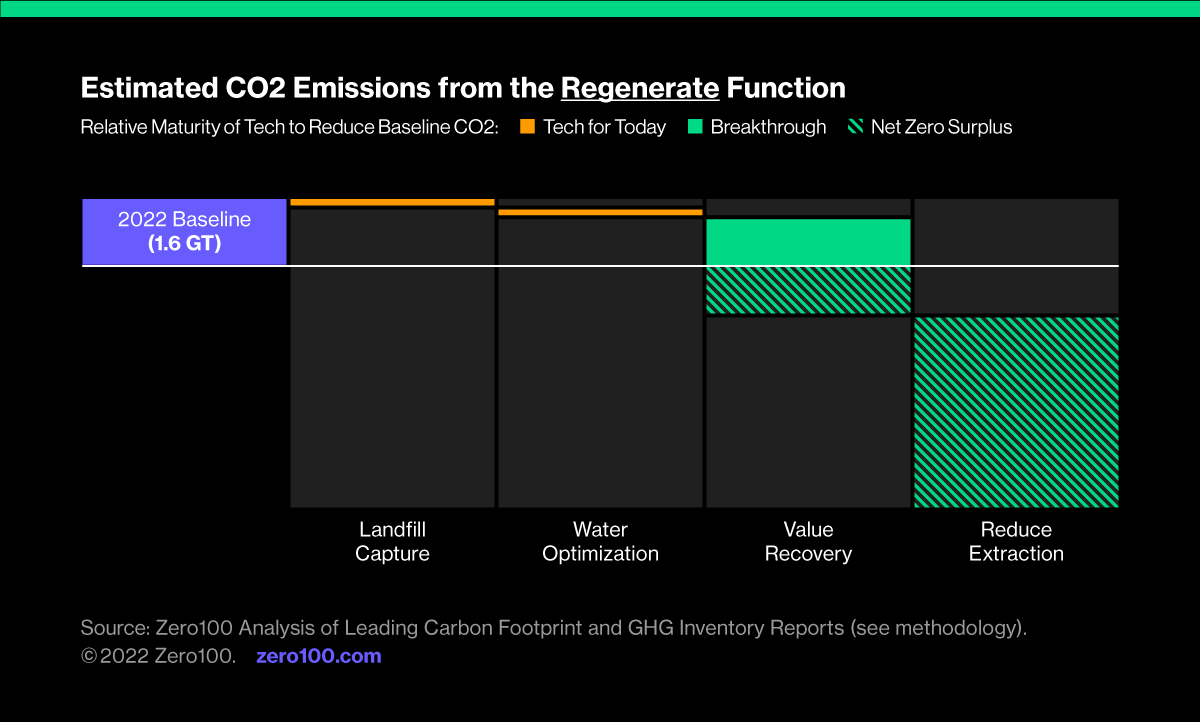
Taking the Next Digital Step Toward Decarbonization
Supply chain leaders can take the next step to digitize to decarbonize by levering “Tech for Today” and investing in “Breakthroughs for Tomorrow” – potentially through collective action.
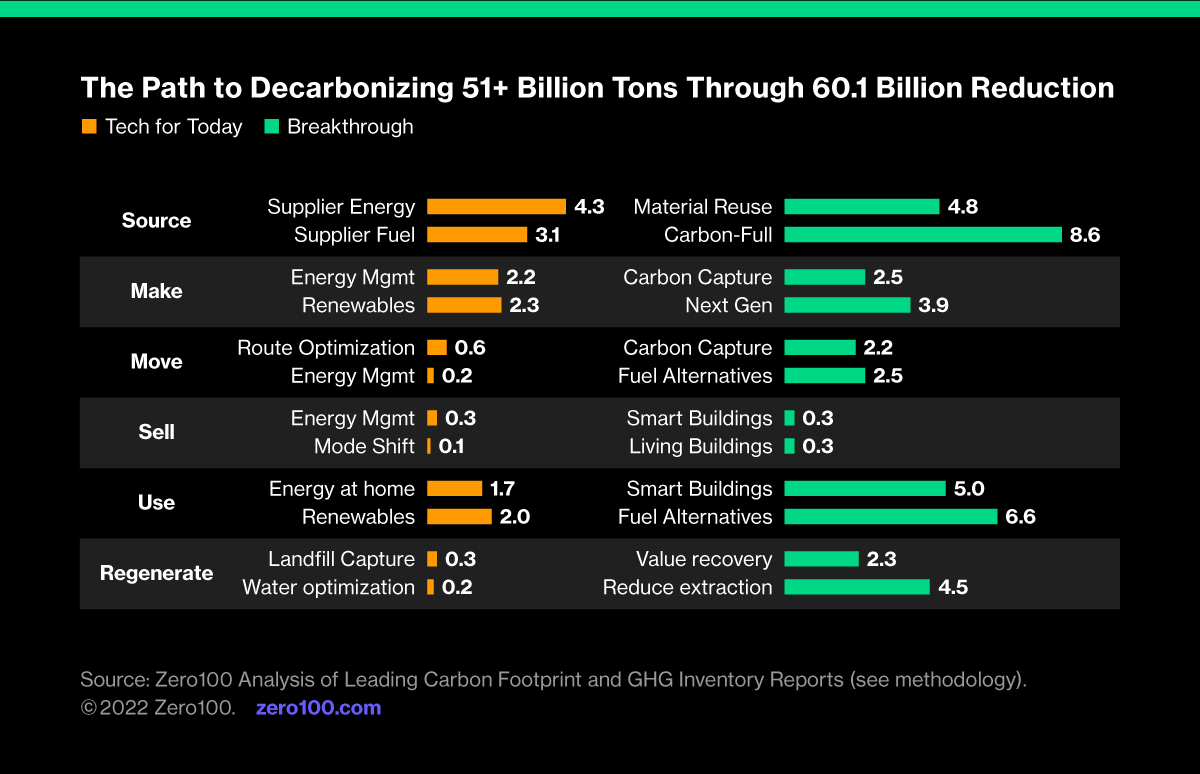
As the next chapter of the research, we set off on a mission to analyze the vendor landscape and create a Decarbonizing Supply Chain Vendor Guide. While we have identified dozens of carbon calculation solution providers, we have not found the success stories and reference customers for solutions focused especially on emissions reduction within a specific supply chain function.
This may be indicative of a maturing market that relies on calculating general emissions levels by applying emissions factors. It’s an important starting point, but not what supply chain leaders are asking for in terms of capturing actual emissions, completely carbon-based scenario analysis, and measuring meaningful improvement from baseline.
Therefore, the next research in this series will focus on a functional view of a Shopper’s Guide. We believe – based on interviews with over 100 different supply chain functional leaders – that rather than one Shopper’s Guide, you will benefit more from more in-depth, function-based Shopper’s Guides.
We are keenly watching the carbon management solution provider market and anticipate impressive growth and focus on this space through 2023, with solutions becoming more useful for supply chain leaders to make measurable improvements in carbon reduction.
Methodology
The majority of public carbon footprint and GHG emissions reports estimate 51 billion tons of global CO2 are released each year. For supply chains, data sources including OECD, Our World in Data, and IEA provide a segmented view as to where the 51 billion tons is dispersed throughout our networks.
We aggregated 10 different carbon emissions data sources to create a consensus view of emissions within each of six supply chain functions (Source, Make, Move, Sell, Use, Regenerate). See the Zero100 Loop for more details on this organizing framework.
For example, Energy which accounts for approximately 36 billion tons of CO2e, can be filtered it down to its emission source such as Transport (10.5 billion tons CO2e), and its emissions subcategory such as Road Freight (3.1 billion tons Co2e), Rail (0.1 billion tons CO2e), Aviation Freight (0.2 billion tons Co2e).
Additionally, a sector like Energy can be broken down to an emission source of production, emissions subcategory of plastic, and further into the specific plastic production occurring (PET, HDPE, etc.).
The purpose of this report is to breakdown the details of carbon emissions from supply chains in a new manner. In so doing, we take a new step towards prioritizing initiatives, engaging with solution providers, and improving scenario planning—by visualizing where we can expect the most return on investment against the Net Zero challenge.
With industry standards and reporting structures varying across industries, our analysis is by no means perfect. Yet, our aggregation of these data points has allowed us to create a starting point for “Digitize to Decarbonize” possibilities in supply chains.
Relevant Data Sources
1. Emissions by sector—Our World in Data
2. Rhodium Group
3. Transport—Our World in Data
4. Every Building in America—an Analysis of the US Building Stock (substack.com)
5. Greenhouse Gas Emissions from Energy Data Explorer – Data Tools—IEA
6. Food production is responsible for one-quarter of the world’s greenhouse gas emissions—Our World in Data
7. Greenhouse gas emissions from plastics lifecycle (oecd.org)
8. Plastic leakage and greenhouse gas emissions are increasing—OECD
9. Science Daily- Growing carbon footprints of plastic
10. Statista-Share of Renewables in Power Generation
11. Renewable Energy Options for the Industry Sector: Global and Regional Potential until 2030, a backgroundpaper
12. Strategies to reduce the global carbon footprint of plastics | Nature Climate Change
References
1. Marcus, Fairs “Carbon Is the Most Valuable Resource in Our Society.” Dezeen, 4 July 2021
2. Staff, GE Aviation News. “Game Changer: Four Parts Proving Additive Manufacturing Can Compete with Casting on Cost – the GE Aerospace Blog: Aviation & Flight News.” The GE Aerospace Blog | Aviation & Flight News, 7 May 2021
3. McKinnon, Alan C. Decarbonising Logistics Distributing Goods in a Low Carbon World. Kogan Page, 2018.
4. Levin, Tim. “The Decline of the American Mall Has Left Just 700 Still Standing. Soon There May Be Just 150 Left.” Business Insider, 12 Oct. 2022
5. Brandon, Elissaveta. “5 Clever Ways Malls Are Being Reinvented across the U.S. – Fast Company.” Fast Company, 6 June 22
6. Pena, Robert. “Bullitt Center High Performance Building Case Study.” University of Washington, Northwest Energy Efficiency Alliance, 2014
7. Randall, Tom. “The World’s Smartest Office Building Knows How You like Your Coffee.” Bloomberg.com, Bloomberg, 23 Sept. 2015
8. Ritchie, Hannah, et al. “Emissions by Sector.” Our World in Data, 11 May 2020